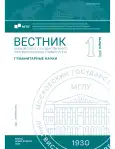Rising Tone Realization in Native and Nonnative Speech
- Авторлар: Sukhova N.1
-
Мекемелер:
- National University of Science and Technology "MISIS" Pushkin State Russian Language Institute
- Шығарылым: № 1(895) (2025)
- Беттер: 98-104
- Бөлім: Linguistics
- URL: https://journal-vniispk.ru/2542-2197/article/view/279193
- ID: 279193
Дәйексөз келтіру
Толық мәтін
Аннотация
The present study aims at analyzing the cross-linguistic influence of the rising tone realization in native and nonnative speech in the tone placement in the phrase and its pitch contour configuration. The comparative and speech acoustic analyses were employed. The material consists of the speech recordings provided by the Russian- and English-speaking respondents. The findings evidence the cross-linguistic influence of the rising tone realization. It is manifested in the converging phrase illocutionary force and the tonal meaning. The nonnative speech pitch contour has its own parameters rather than being an echo of the native contour.
Авторлар туралы
Natalya Sukhova
National University of Science and Technology "MISIS"Pushkin State Russian Language Institute
Хат алмасуға жауапты Автор.
Email: suhova.nv@misis.ru
Ресей
Әдебиет тізімі
- Vishnevskaya, G. M. (1990). Metodologija i metodika jeksperimental’no-foneticheskih issledovanij = Methodology and methods of phonetic experiments. Ivanovo. (In Russ.)
- Bergman, C., Nota, A., Sprenger, S. A., Schmidt, M. S. (2016). L2 immersion causes non-native-like L1 pronunciation in German attritors. Journal of phonetics, 58, 71–86.
- Flege, J. E., Bohn, O. S. (2021). The revised speech learning model (SLM-r). In Wayland, R. (ed.), Second language speech learning: Theoretical and empirical progress (pp. 3–83). Cambridge: Cambridge University Press.
- Sukhova, N. V. (2023). The perception-production link in the Russian-English prosodic interference (the case study of terminal tones). Vestnik of Moscow State Linguistic University. Humanities, 6(874), 131–137.
- Lee, J., Park, H. (2024). Acoustic cue sensitivity in the perception of native category and their relation to nonnative phonological contrast learning. Journal of Phonetics, 104, 101327.
- Kim, D., Clayards, M., Goad, H. (2018). A longitudinal study of individual differences in the acquisition of new vowel contrasts. Journal of Phonetics, 67, 1–20.
- Tsibulya, N. B. (2023). Gestures-illustrators with the meaning of contrast and their prosodic correlates. Vestnik of Moscow State Linguistic University. Humanities, 3(871), 129–135. (In Russ.)
- Kasatkin, L. L. (2007). Russkaja intonacija: tonal’nye kontury. Problemi fonetiki = Russian intonation: pitch contours. Issues in Phonetics, 5, 250–266. (In Russ.)
- Volskaya, N. B., Skrelin, P. A. (2009). Sistema intonacionnyh modelej dlja avtomaticheskoj interpretacii intonacionnogo oformlenija vyskazyvanija: funkcional’nye i perceptivnye harakteristiki = System of intonation models for automatic intonation contours’ detection: Functional and perceptual characteristics (pp. 28–41). Trudy tret’ego mezhdisciplinarnogo seminara «Analiz razgovornoj russkoj rechI» (AR3–2009). St. Petersburg: GUAP. (In Russ.)
- Proshina, Z. G. Language and its varieties – reality or virtuality? The Humanities аnd Social Studies in the Far East, XVIII(3), 108–113. (In Russ.)
- Fokina, S. L. (2013). Akcentuacija terminologicheskih slovosochetanij v pod’jazyke nanotehnologij (na materiale anglijskogo jazyka) = The accentuation of the terminological word combinations in the nantechnological field: PhD in Philology. Yaroslavl’. (In Russ.)
- Steffman, J., Cole, J., Shattuck-Hufnagel, S. (2024). Intonational categories and continua in American English rising nuclear tunes. Journal of Phonetics, 104, 101310.
- Svetozarova, N. D. (1982).Intonacionnaja sistema russkogo jazyka = Intonation system of the Russian language. Leningrad. (In Russ.)
- Kodzasov, S. V. (1999). Urovni, edinicy i processy v intonacii. = Levels, units and processes in intonation. Problemi fonetiki, 3, 197–215. (In Russ.)
- Pierrehumbert, J. (1980). The phonology and phonetics of English intonation. Doctoral dissertation. Massachusetts Institute of Technology.
- Odé, C. (2007). Zametki o ponjatii tonal’nyj akcent na primere russkogo jazyka = Notes on pitch accents with the example of the Russian language. Problemi fonetiki, 5, 237–250 (In Russ.)
- Kibrik, A. A., Podlesskaya, V. I., Korotaev, N. A. (2009). Struktura ustnogo diskursa: osnovnye jelementy i kanonicheskie javlenija = Spoken discourse structure: main elements and canonic phenomena. In Kibrik, A., Podlesskaya V. I. (Eds.), Night Dream Stories: A corpus study of spoken Russian discourse (pp. 55–102). Moscow: Languages of Slavonic Culture. (In Russ.)
- Yanko, Т. Е. (2008). Intonacionnye strategii russkoj rechi v sopostavitel’nom aspekte = Intonational strategies of the Russian speech in the comparative aspect. Moscow: Languages of Slavonic Culture. (In Russ.)
- Grant, L. (2011). Well Said! 2nd edition. Cengage Learning.
- Parshina, O., Zdorova, N., Kuperman, V. (2024). Cross-linguistic comparison in reading sentences of uniform length: Visual-perceptual demands override reader’s experience. Quarterly Journal of Experimental Psychology, 8, 1694–1702.
- Kim, S.-E., Tilsen, S. (2024). Planning for the future and reacting to the present: Proactive and reactive F0 adjustments in speech. Journal of Phonetics, 104, 101322.
Қосымша файлдар










